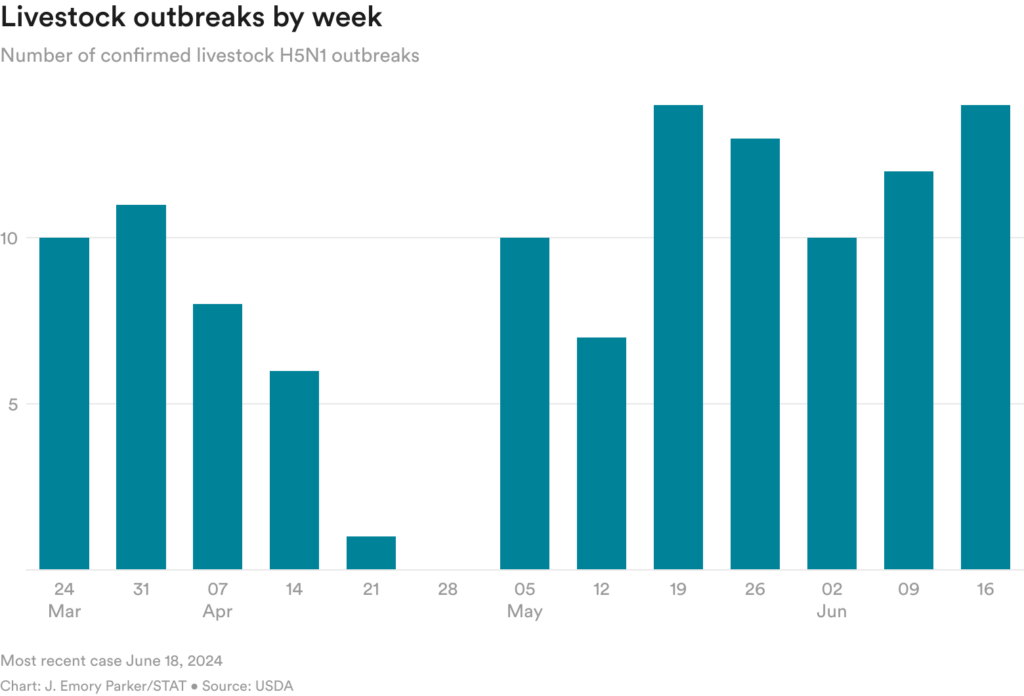
Bird flu snapshot: This is the second installment in a series of regular updates on H5N1 avian flu that STAT is publishing on Monday mornings. To read future updates you can also subscribe to STAT’s Morning Rounds newsletter.
As the H5N1 outbreak in dairy herds approaches the three-month mark, America’s top animal health official is calling on farmers to step up the use of personal protective equipment, limit traffic onto their farms, and increase cleaning and disinfection practices in their barns and milking parlors.
“The more we learn about H5N1, the more we understand that good biosecurity is a critically important path to containing the virus,” U.S. Department of Agriculture Secretary Tom Vilsack wrote in an Agri-Pulse op-ed on Friday. Epidemiological investigations have revealed that the disease likely spreads between dairies in a community through the movement of people — on boots or clothing — and on vehicles and equipment, he wrote, emphasizing the need for more stringent hygiene measures.
Vilsack’s plea comes at a time when it’s becoming clear that in addition to slow-walking the testing of animals and farmworkers and resisting the use of personal protective equipment, the dairy industry is also struggling to effectively separate sick cows and limit their movement. In a recent USDA survey of affected farms, 60% of respondents acknowledged moving animals off the farm after some of their cows started showing bird flu symptoms.

Vilsack stressed that the USDA has many ways to support producers, including providing direct funds for enhanced biosecurity plans, and to cover the costs of having veterinarians take samples from animals and send them off to laboratories for H5N1 testing.
However, the USDA’s own data show that uptake of these resources has so far been dismal. Farmers of only four herds — in Texas, Kansas, New Mexico, and Nebraska — have enrolled in a USDA voluntary testing pilot program since its launch on June 3. Participants in the program agree to monitor milk from on-farm bulk tanks with weekly testing; three weeks of consecutive negative samples will exempt farmers from a federal order mandating testing of individual animals prior to movement across state lines. Since the federal order went into effect on April 29, a slow but steady drip of new infections have been reported in an increasing number of states.
As of Friday, the USDA had confirmed infections in 116 herds in 12 states; Iowa and Colorado each announced this week additional herds that haven’t yet made it to the USDA list. To date three people — all farmworkers — have contracted the virus from cows. All three individuals experienced mild symptoms and have fully recovered.
While the Centers for Disease Control and Prevention considers the current risk of H5N1 to the general public to be low, people who work with dairy cows, handle or consume raw milk, or come into contact with cow carcasses without proper PPE should all be considered at the highest risk, according to new guidance the public health agency released last Thursday.
There are still open questions about the mechanics of how the virus is spreading between cows within a herd and between farms, but evidence that animals are getting infected during the milking process continues to mount. In May, researchers at the University of Pittsburgh and Emory University reported that the H5N1 virus can remain infectious on surfaces commonly found in milking equipment materials for up to three hours. Last Thursday, German researchers reported that cows experimentally infected with two strains of H5N1 — including the one spreading in the U.S. — directly in their teats showed clear signs of disease, including fever, a sharp drop in milk production, and changes in milk consistency.

To submit a correction request, please visit our Contact Us page.











STAT encourages you to share your voice. We welcome your commentary, criticism, and expertise on our subscriber-only platform, STAT+ Connect